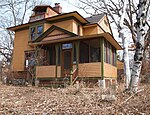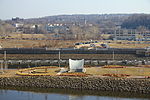Colorado Street Bridge (Saint Paul, Minnesota)
Arch bridges in the United StatesBrick bridges in the United StatesBridges completed in 1888Bridges in Saint Paul, MinnesotaFormer road bridges in Minnesota ... and 9 more
Midwestern United States bridge (structure) stubsMinnesota Registered Historic Place stubsMinnesota building and structure stubsMinnesota transportation stubsNational Register of Historic Places in Saint Paul, MinnesotaPedestrian bridges in MinnesotaRoad bridges on the National Register of Historic Places in MinnesotaSaint Paul, Minnesota stubsSkew bridges

The Colorado Street Bridge also known as Bridge L-8803 is a masonry and brick arch bridge in Saint Paul, Minnesota's West Side neighborhood. It is 58 feet (18 m) wide and consists of a single oblique span of 70 feet 6 inches (21.49 m) that was built with the arch courses running parallel to the abutments, leading to a weaker structure than other skew arch construction methods, known as a false skew arch. It was designed in 1888 by Andreas W. Munster of the Saint Paul Engineer's Office and is now restricted to pedestrian traffic.
Excerpt from the Wikipedia article Colorado Street Bridge (Saint Paul, Minnesota) (License: CC BY-SA 3.0, Authors, Images).Colorado Street Bridge (Saint Paul, Minnesota)
Torre de San Miguel, Saint Paul West Side
Geographical coordinates (GPS) Address Nearby Places Show on map
Geographical coordinates (GPS)
| Latitude | Longitude |
|---|---|
| N 44.934722222222 ° | E -93.084166666667 ° |
Address
Torre de San Miguel
Torre de San Miguel
55107 Saint Paul, West Side
Minnesota, United States
Open on Google Maps









